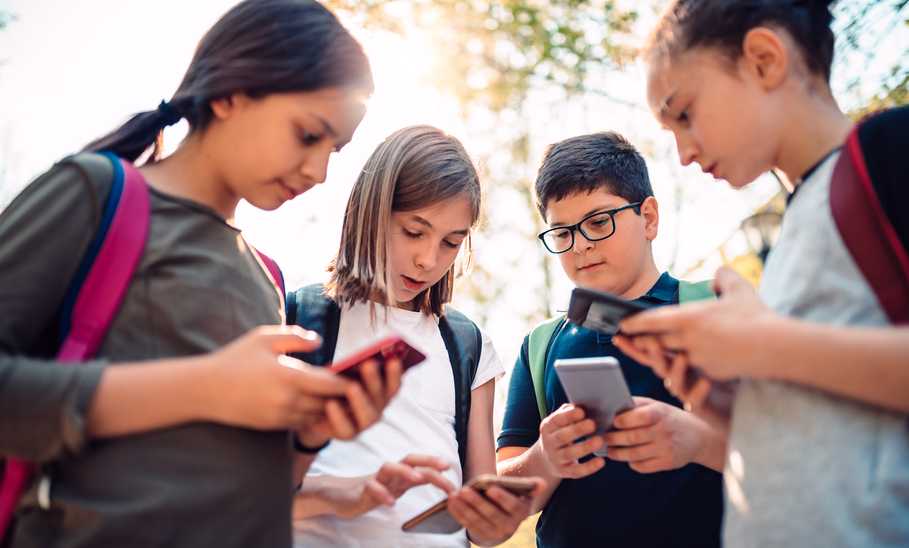Phones have become such an indispensable part of our daily lives, it’s hard to remember what we did without them. But one of the many side effects of our being joined at the hip with our phones is that our kids are asking for their own at a younger and younger age. While you likely—and correctly—have some reservations about this, there are also a whole bunch of advantages to your child having a phone, especially if they’re old enough to be going out unsupervised. Below, you’ll find our choices for the best phones for kids, along with tons of expert advice on how best to navigate the minefield.
Our top picks for the best phones for kids
Best entry-level iPhone for kids: iPhone SE
![[object Object] [object Object]](https://m.media-amazon.com/images/I/6143ykh8CGL.*AC_SX679*.jpg)
iPhone SE
On one hand, you want your child to have the best device you can give them. On the other hand, you know it’s just a matter of days before that $900 iPhone 14 gets dropped in the toilet. Picking a slightly more wallet-friendly phone for your kid’s first device just makes sense, then. “If iPhones come with an ‘entry-level’ version, it’s the iPhone SE,” says Steven Athwal, managing director at The Big Phone Store. “The 2022 version of this classic iPhone, with its large ‘home’ key and rugged plastic casing, is the kind of phone that you can drop once or twice without worrying if it will break apart.”
Specifications
- Display: 4.7-inch Retina HD
- Memory: 4 GB
- Storage: 64, 128, or 256 GB
- Battery: Built-in rechargeable lithium-ion battery
- Rear camera: 12MP
- Front camera: 7MP
- Warranty: 1 year
- Price on publish: From $429
Cons:
- Some reviews complain of worse-than-expected battery life
![[object Object] [object Object]](https://m.media-amazon.com/images/I/41ARIjyntbL._SL500_.jpg)
Xiaomi Redmi A1
“If you’re having to pay for the whole cost of a phone at once, you’re probably looking for something that doesn’t cost the earth,” says Athwal. “That’s why I’d recommend something like the Xiaomi Redmi, a budget smartphone that is still a very capable handset.” Despite its budget price, it comes with an 8MP dual main camera and a 5MP selfie camera (more than enough for a kid taking endless “Look at my silly face!” shots), and a micro-SD card expansion slot, so there’s somewhere to store all those selfies.
Specifications
- Display: 5.5-inch LCD
- Memory: 2 GB
- Storage: 32 GB
- Battery: Rechargeable lithium polymer battery
- Rear camera: 8MP
- Front camera: 5MP
- Warranty: Not listed
- Price on publish: $82.50
Pros:
- Great performance on inexpensive device
Best phone for kids under age 12: Gabb Phone
![[object Object] [object Object]](https://gabb.com/wp-content/uploads/2021/02/new-gabb-phone-photo.png)
Gabb Phone
“The Gabb Phone Z2 is a great option for younger kids,” says Yaron Litwin, CMO at parental control app Canopy. “It lets you keep track of them via GPS and has several pre-installed, safe programs on the phone, but otherwise does not allow for additional apps and internet connectivity. This is meant to keep your kids as safe as possible and to give them a phone hermetically sealed from any explicit content.” Athwal agrees, adding that it’s, “A very limited smart device, only allowing access to 14 kid-safe apps. There’s no web browsing, no YouTube, no social media, and no games, meaning kids can get access to a ‘my first smartphone’ experience that works as a tool, not as a distraction.”
Specifications
- Display: 5.4-inches
- Memory: 2 GB
- Storage: 32 GB
- Battery: Rechargeable lithium-ion battery
- Rear camera: 8MP
- Front camera: 5MP
- Warranty: $4.99 a month
- Price on publish: $134
Pros:
- Good battery life
- Blocks pretty much anything you’d worry about as a parent (internet, social media, etc.)
![[object Object] [object Object]](https://m.media-amazon.com/images/I/61JfY-8odVL.*AC_SX466*.jpg)
Samsung Galaxy A13
Even if you’re a diehard Apple fanatic, it’s well worth considering an alternative for your kids, for the price difference alone. “The Samsung Galaxy A13 balances affordability with functionality, and definitely has the kid-friendly credentials, being the phone that both the Bark Phone and Gabb Phone Plus are based on,” says Athwal. “Samsung phones come with several parental controls of their own, including a ‘kids’ mode that only allows access to a special kid-friendly app store.”
Specifications
- Display: 6.6-inch Infinity-V
- Memory: 3 GB
- Storage: 32 or 64 GB
- Battery: 5,000-mAh
- Rear camera: 50MP main camera, 5MP ultra-wide camera, 2MP macro camera, 2MP depth camera
- Front camera: 8MP
- Warranty: 1 year
- Price on publish: From $159.99
Pros:
- Relatively inexpensive
- Good battery life
Cons:
- Some reviews complain of poor screen brightness
![[object Object] [object Object]](https://d12jofbmgge65s.cloudfront.net/wp-content/uploads/2023/07/phone-pc-badge-893x1024.png)
Bark Phone - price per month
If you like the idea of the Samsung phone above, but want a little more peace of mind, this is the one for you. “The Bark Phone is a modified Samsung Galaxy A13, designed around child safety,” explains Athwal. “This device comes with a huge variety of parental controls baked into the operating system, giving parents full control over things like which apps their children can access, and being able to see the messages that your child is sending and receiving. Unlike other parental-control phones, the Bark phone allows access to the Google Play store, meaning that this still definitely counts as an Android device.” The security plus the “feels like a ‘real’ phone” aspect makes it one of the best gifts for kids who have been constantly asking for their own smartphone.
Specifications
- Display: 6.6 inches
- Memory: 3 GB
- Storage: 32 GB
- Battery: 5,000-mAh
- Rear camera: 50MP
- Front camera: 8MP
- Warranty: Not listed
- Price on publish: From $49 a month
Pros:
- Great parental controls
- Feels like a regular smartphone
Cons:
- Not water-resistant
- A little big for younger kids
![[object Object] [object Object]](https://m.media-amazon.com/images/I/61RiO719umL.*AC_SX466*.jpg)
Nokia 2780 Flip
Despite your kid’s incessant pestering, it could well be that this isn’t the right time for them to own a smartphone. In which case, consider going somewhat old school with the Nokia 2780, a flip phone with some necessary modern updates. “With all the basic features your child will need, including Google Maps and WhatsApp, this flip phone is a colorful, stylish choice for any child who isn’t yet ready for a smartphone,” says Athwal.
Specifications
- Display: 2.7 inches
- Memory: 4 GB
- Storage: 512 MB
- Battery: 1450-mAh
- Rear camera: 5MP
- Front camera: None
- Warranty: 1 year
- Price on publish: $89.99
Pros:
- Inexpensive
- Kid-friendly
- Durable
![[object Object] [object Object]](https://m.media-amazon.com/images/I/510Fpe16MoL.*AC_SX679*.jpg)
Apple iPhone 12
“Released in 2020, the iPhone 12 is reaching the Goldilocks zone of mobile phones—still new enough that it’s covered by Apple’s security updates, but old enough that it’s becoming a very affordable choice for a parent who’s anxious to not let their child have a thousand-dollar phone,” says Athwal. “Packed with all the awesome features that you can only find on flagship iPhones, like the best-in-class cameras and Macbook connectivity, this is a great choice for a child who’s begging you to just let them have an iPhone. To make this an even more affordable choice, maybe consider buying a refurbished model rather than a brand-new one.”
Specifications
- Display: 6.1 inch-OLED
- Memory: 4 GB
- Storage: 64, 128, or 256 GB
- Battery: Built-in rechargeable lithium-ion battery
- Rear camera: 12MP wide, 12MP ultra-wide
- Front camera: 12MP
- Warranty: 1 year
- Price on publish: From $599
Pros:
- Near-top of the line functionality
Cons:
- Still pretty expensive for a kid’s phone
Best watch phone for kids: Gabb Watch 3
![[object Object] [object Object]](https://gabb.com/wp-content/uploads/2023/08/Text-Call.gif)
Gabb Watch 3
Do you want to know the best possible way to stop your kid immediately losing that brand new phone they’ve spent the last six years begging you for? Literally strap it to their body with one of the best smartwatches for kids. “When your children are young, you only need a few things, and the Gabb watch does them all,” enthuses Athwal. “It’s a durable phone that can easily get in touch with mom and dad, without giving your young child the ability to call or text anybody other than you. It also keeps track of where your kids are by GPS, and with the Geofencing mode, you can program it to give you a location alert if your child strays too far from home.” It also has an IP68 water resistance rating, meaning you don’t have to worry about taking trips to the pool or beach. Plus, the talk-to-text function means even your littlest ones can text you.
Specifications
- Display: 1.4 inches
- Memory: 8 GB
- Storage: N/A
- Battery: 500-mAh
- Rear camera: None
- Front camera: None
- Warranty: $4.99 a month
- Price on publish: From $75
Pros:
- Super easy to use
- Durable
- A new software update in November 2023 extended battery life significantly
How we selected the best phones for kids
We made our selections through a combination of advice from experts, in-depth research on what factors matter most when choosing the best phone for kids, and combing through customer reviews to find the most universally popular models.
What to consider when buying phones for kids
“As with most purchases for kids, whether it’s clothes, toys, games, or special-event tickets, it’s important to think about fit,” says Shelley Pasnik, senior vice president at the Education Development Center, a global nonprofit which houses the Center for Children & Technology. “The ubiquity of smartphones is leading to more phones being given to children at increasingly younger ages, but it’s okay to slow down and ask, ‘Is this phone well-matched with this kid?’”
“Consider functionality, which is largely about content (the availability of information) and connection (the availability of people), and whether your child’s maturity and level of responsibility are aligned,” Pasnik continues. “Smartphones can be costly as well as needy—they can pull a young person’s attention in ways that can be confusing. Sometimes a good starting place may be what used to be called a ‘feature phone’, that is, it’s good for texting and calls, and better suited to where a child is developmentally.”
Regarding the phone itself, “The most significant thing you want to consider when buying a phone for your child is the durability, cost, and warranty,” says Dan Quick, president at Mobile Klinik. “The newest smartphones can be expensive, and children may accidentally mishandle them, leading to more expensive repairs.”
“Realistically, your child won't need all the features of the latest phones, so I always recommend shopping pre-owned,” Quick adds. “A Certified Pre-Owned (CPO) device will be examined and repaired by a certified technician using quality parts to ensure the phone runs as good as new, and many retailers will offer a limited warranty guaranteeing their quality craftsmanship. Therefore, you save money on the upfront cost of the device and can have peace of mind in case of malfunctions. Don't forget to buy a quality case for your child's device, which will help protect it from accidental drops.”
How to make your kid's phone safe
“Parents tend to think about phone safety in two ways,” says Pasnick. “One, they want the phone to remain unbroken and un-lost; and two, they want to keep their child safe from harmful content and people for which the phone can serve as a gateway. For the first kind of safety, I have one recommendation: Insurance. Phones inevitably are lost, stolen, and damaged even with the most conscientious child.”
“The second kind of safety is more layered,” Pasnick continues. “Technological supports, like privacy software, can be useful and there are many good resources online about child-friendly tech tools. These tools, though, are not a replacement for the ongoing conversations that grown-ups need to have with kids about what they are seeing, hearing, and believing based on information they encounter via apps and games. Kids’ use of phones in particular and media in general changes over time, as do kids, and talking about experiences is a healthy part of growing up.”
“To ensure the device is not damaged, invest in a quality case and screen protector at the time of purchase,” advises Quick. “Depending on your child's age, there are different features you can disable through parental controls in the device's settings. App downloading is already password protected on smartphones, so you can preload your child's phone with kid-friendly apps. Additionally, ensure you have emergency contacts saved and your child knows how to access them.”
“Apps like Google Family Link, FamilyTime, Qustodio, ESET Parental Control, WebWatcher, and more are all great options to monitor what your kid is up to on the phone,” adds Dana Oliver, president and founder of Adventure Kids Playcare.
How to track your kids for safety purposes
“Most phones that are made for children come with GPS tracking software, battery percentage monitoring, and more,” says Oliver. “A child in middle school’s expectation of privacy will look a lot different than a 14-year-old or 15-year-old. It’s important, no matter what, to establish open—but firm—lines of communication. Emphasize that yes, your child has a right to text friends and hang out with them, but as the parent, you have the right to know where they are, who they’re hanging out with, and when they will be home.”
“As your child gets older and turns to high school and college, it will be easier to have an adult conversation about why it’s so important for people to know where they are,” Oliver continues. “Life 360 is one of the apps that many college students use to keep track of each other and their friends. Coming up with a family ‘circle’ where everyone can see each other is a great way to practice honesty, transparency, and safety. Emphasizing that it’s not your child whom you don’t trust, but other strangers in the world, will prevent your teenager from feeling belittled or infantilized, and will make them more willing to share their locations with you.”
“Find My iPhone and Life 360 are my go to,” says Reena B. Patel, parenting expert and licensed Educational Board certified behavior analyst. “Yes, even for older children. Make it a family rule that every member, even parents, can be tracked for safety purposes. Do discuss this rule with the family and how safety plays a role. Parents of young adults can know where their child is, but should allow for autonomy and not question where they are. This will help maintain your ability to track.”
“As tempting as it may be, phones are not a good excuse for parental sneakiness or surveillance,” agrees Pasnick. “Trust is the better way to go, which requires talking across the generational divide. Many parents and kids talk openly about how a phone can be helpful in knowing where one another is, especially when it comes to safety.”
Frequently asked questions (FAQs)
What is the best phone for a kid’s first phone?
“The best phone for your child will depend on their age and the features that are necessary for them to access,” says Quick. “Consider size, as children's smaller hands have trouble using larger phones. If your child is younger, you may opt for a simple voice and text phone over a smartphone. For teenagers, a smaller version of popular smartphones, such as the iPhone SE, may be more suitable and affordable than newer models.”
Is there a phone for kids that only includes texts and calls?
“There are several models designed just for kids,” says Oliver. “Some require parents to enter all phone numbers, so kids can only send and receive calls from approved individuals. Phones like the Gabb phone have features to limit screen time, social media, games, and unrestricted access to the internet. Parents can have full access and control over these smartphones if need be. These protective features prevent kids from cyberbullying or grooming while also minimizing the potential for screen addiction. It doesn’t have games or social media, but has unlimited texting, calling, GPS tracking, and reliable network, which enforces making connections and nurturing relationships in a healthy way.”
Should an 11-year-old have a phone?
“Should an 11-year-old be able to reach out to their parents and update them on their whereabouts at all times? Yes, of course,” says Oliver. “But if we’re talking about ‘phones’ as in fully-functional iPhone or Android phones, complete with internet browsing and social media, then no. An 11-year-old should not be worried about curating an online presence or following, and is far too young to be using social media for the practical reasons of networking for jobs, looking for colleges, and so on. For a middle schooler, all they really need to be doing in their lives is walking to and from school, going to extracurriculars, and hanging out with friends. This requires that the parents know where they are and know when and where to pick them up, meaning a simple phone with simple, controlled calling and texting will suffice. Maturity and the needs of a child vary from family to family.”
What is the ideal age for a first phone?
“Whenever you will need to get in touch with your child when they are away from you,” says Patel. “This can be for school, camp, at friends' houses. Whenever your child starts to do activities like this, it is a great time to get a phone for communication and emergency purposes.”
“Similar to driving, there’s no set age at which a kid is ready or not ready,” says Oliver. “A 16-year-old may not be ready to drive yet or buy a car, even if they’re technically allowed to. Some kids may wait longer than 16 to take their driving test, while a 15-year-old who practices with mom and dad will already have prior experience going into driver’s ed. It all depends on the parent and child, and their level of maturity. Is your child getting good grades and making an effort to nurture their relationships and hobbies? Are they helping around the house and showing that they’re ready for more responsibility? Maturity can be hard to gauge in individuals.”
“What’s equally important is how and why to say no if you think your kid isn’t ready—don’t just say they’re too young (even if they are),” Oliver continues. “Try emphasizing that their safety is your top priority, or that there are other ways to talk to and connect with friends besides using a phone to text. I recommend discussing privacy and caution with things like giving out their number, and exercising courtesy in situations in which your kid shouldn’t be using your phone, like at a movie theater, during class, or when someone is trying to talk to them face-to-face.”


![[object Object] [object Object]](https://m.media-amazon.com/images/I/6143ykh8CGL.*AC_SX679*.jpg)
![[object Object] [object Object]](https://m.media-amazon.com/images/I/41ARIjyntbL._SL500_.jpg)
![[object Object] [object Object]](https://gabb.com/wp-content/uploads/2021/02/new-gabb-phone-photo.png)
![[object Object] [object Object]](https://m.media-amazon.com/images/I/61JfY-8odVL.*AC_SX466*.jpg)
![[object Object] [object Object]](https://d12jofbmgge65s.cloudfront.net/wp-content/uploads/2023/07/phone-pc-badge-893x1024.png)
![[object Object] [object Object]](https://m.media-amazon.com/images/I/61RiO719umL.*AC_SX466*.jpg)
![[object Object] [object Object]](https://m.media-amazon.com/images/I/510Fpe16MoL.*AC_SX679*.jpg)
![[object Object] [object Object]](https://gabb.com/wp-content/uploads/2023/08/Text-Call.gif)



